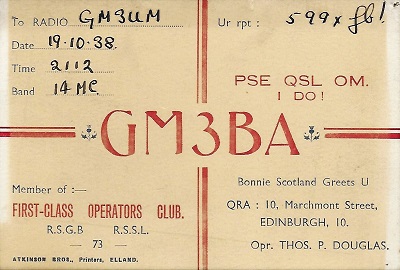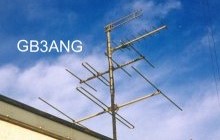Photographs from the early years of LRS
- Details
- Written by Alan GM3PSP
- Hits: 1461


Tom Douglas G3BA 1969.(SK 1994). QSL for 1938 QSO with LRS member, George Millar GM3UM.
Tom Douglas G3BA, was originally from Edinburgh (QTH 10 Marchmont Street) before the Lothians Radio Society was founded in the late-1940s. He was a well-known VHF amateur in the 1960s, as RSGB VHF Manager and writing the monthly VHF page for RadCom magazine. Latterly he was Engineer-in-Charge (EiC) of the BBC TV transmitting station at Sutton Coldfield near Birmingham.
He was a keen VHF contester and used a site on a hilltop near Gatehouse of Fleet, on the south coast of Dumfries & Galloway with a clear take-off to the south and the Isle of Man visible on clear days. That site is now used for portable contests such as VHF NFD by the Lothians Radio Society, GM3HAM/P.
During WW2 Tom, as an Officer with the Royal Corps of Signals, was captured by the Japanese and spent several years in Siam working on the construction of the railway line made famous by the film Bridge on the River Kwai. In the PoW camps he worked clandestinely building and operating radio receivers known as "Dicky Birds" to receive radio news broadcasts for the benefit of the prisoners.
Recently some letters and a newspaper article have been found which describe Tom's work with the Dicky Birds. These have been transcribed and are presented here. Sections specific to Tom are highlighted in red.
Read more: 1940s - Tom Douglas G3BA WWII PoW Radio Man in Siam (Thailand)
- Details
- Written by Alan GM3PSP
- Hits: 1309

In January 1982 a group of amateurs, including several from the Lothians Radio Society, installed beacons for 6m, 2m, 70cm and 23cm in the county of Angus, using the callsign GB3ANG. Photos courtesy Chris Tran GM3WOJ.
Read more: 1982 - GB3ANG Beacons Installation by LRS Members et al
- Details
- Written by Alan GM3PSP
- Hits: 1172

Lieutenant Roy Dawson, later GM3GBX
Many thanks to Nick Dawson for providing this story about his father Roy Dawson, GM3GBX who was a member of the LRS probably in the 1950s. The following piece is taken from a newspaper article describing his amateur radio activities while serving as a Lieutenant in the Royal Corps of Electrical and Mechanical Engineers (REME) in the British Army of the Rhine in Germany after WWII. After demobilization he came to Edinburgh and worked at Ferrianti on Navigation Systems.
Read more: 1940s - "Rutherglen BAOR Officer on Air to Home" (GM3GBX)
- Details
- Written by Alan GM3PSP
- Hits: 1769

Brian GM4DIJ on East Lomond Hill in Fife for the UHF/SHF contest about 1996.
Brian Howie GM4DIJ built and operated portable 3cm equipment in the 1970s using Cassegrain parabolic dishes which had been scrapped by Ferranti from their Blue Parrot radar system, developed in Edinburgh. He started with wideband gear using Gunn diodes and klystrons.
Brian writes: the Cassegrain configuration is quite clever. The dish consists of an array of wires at 45 deg, and the secondary reflector, horizontal wires. Horizontally polarised incoming signals pass through the secondary reflector but are rotated to vertical polarisation by the dish and then can be reflected by the secondary reflector onto the horn feed. This largely removes the aperture loss caused by the reflector. That's why on my dish, the polarisation of the waveguide is vertical.
Page 1 of 3

